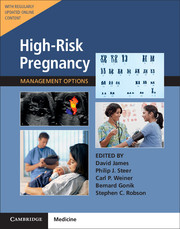Book contents
- Frontmatter
- Contents
- List of Contributors
- Preface
- Section 1 Prepregnancy Problems
- Section 2 Early Prenatal Problems
- Section 3 Late Prenatal – Fetal Problems
- Section 4 Problems Associated with Infection
- Section 5 Late Pregnancy – Maternal Problems
- Section 6 Late Prenatal – Obstetric Problems
- 52 Abdominal Pain in Pregnancy
- 53 Nonmalignant Gynecology in Pregnancy
- 54 Bleeding in Late Pregnancy
- 55 Multiple Pregnancy
- 56 Threatened and Actual Preterm Labor
- 57 Prelabor Rupture of the Membranes
- 58 Breech Presentation, Unstable Lie, Malpresentation, and Malpositions
- 59 Prolonged Pregnancy
- 60 Induction of Labor and Termination of the Previable Pregnancy
- 61 Dysfunctional Labor
- 62 Shoulder Dystocia
- 63 Fetal Compromise in Labor
- 64 Neuraxial Analgesia and Anesthesia in Obstetrics
- 65 Perineal Repair and Pelvic Floor Injury
- 66 Assisted Vaginal Delivery
- 67 Delivery After Previous Cesarean Section
- 68 Cesarean Section
- Section 7 Postnatal Problems
- Section 8 Normal Values
- Index
68 - Cesarean Section
from Section 6 - Late Prenatal – Obstetric Problems
- Frontmatter
- Contents
- List of Contributors
- Preface
- Section 1 Prepregnancy Problems
- Section 2 Early Prenatal Problems
- Section 3 Late Prenatal – Fetal Problems
- Section 4 Problems Associated with Infection
- Section 5 Late Pregnancy – Maternal Problems
- Section 6 Late Prenatal – Obstetric Problems
- 52 Abdominal Pain in Pregnancy
- 53 Nonmalignant Gynecology in Pregnancy
- 54 Bleeding in Late Pregnancy
- 55 Multiple Pregnancy
- 56 Threatened and Actual Preterm Labor
- 57 Prelabor Rupture of the Membranes
- 58 Breech Presentation, Unstable Lie, Malpresentation, and Malpositions
- 59 Prolonged Pregnancy
- 60 Induction of Labor and Termination of the Previable Pregnancy
- 61 Dysfunctional Labor
- 62 Shoulder Dystocia
- 63 Fetal Compromise in Labor
- 64 Neuraxial Analgesia and Anesthesia in Obstetrics
- 65 Perineal Repair and Pelvic Floor Injury
- 66 Assisted Vaginal Delivery
- 67 Delivery After Previous Cesarean Section
- 68 Cesarean Section
- Section 7 Postnatal Problems
- Section 8 Normal Values
- Index
Summary
Introduction
History
The delivery of a baby through the abdominal wall, whether by accident, traumatically, or postmortem, has a long history. Self-performed cesarean sections have also been described, as have cesarean sections performed by laypersons, most often in desperation as a result of prolonged labor.
However, it was nearly 450 years ago when someone first considered carrying out a cesarean section (CS) prophylactically in a woman who was unlikely to deliver vaginally and before the woman became so moribund that her death and that of her baby was inevitable. This operative intervention was first described by the French physician François Rousset in 1581. At the time there was wide criticism from the medical establishment of the day. This was the start of a CS debate that continues today, and still with very polarized views. The concept of a risk–benefit ratio has always dominated the discussion, but the nature of the risks and benefits for and against cesarean section have radically changed.
During the sixteenth to eighteenth centuries CS continued to be described, but it remained rare, with most physicians strongly against carrying out the procedure because of its high associated mortality. This mortality was largely related to the poor general condition of the woman at the time the CS was carried out, often the result of prolonged labor. This contributed significantly to the risks of infection and hemorrhage as a result of the operation.
In the nineteenth century an improvement in basic surgical principles and techniques, such as suturing the uterus and employing methods to exteriorize drainage of sepsis and bleeding, helped control the risk of infection and hemorrhage, but CS remained an operation that was carried out in extreme circumstances only. The vertical uterine incision remained the most common incision, although Kehrer first described the transverse lower uterine segment CS in 1881.
A big advance at the end of the nineteenth century was the use of a tourniquet applied around the lower part of the uterus after the baby had been delivered. This restricted the blood loss while the uterus was being sutured. It was first advocated by Murdoch Cameron in Glasgow. In addition, Cameron attempted to select his patients before the mother's condition was compromised by exhaustion and the associated infection of a long obstructed labor.
- Type
- Chapter
- Information
- High-Risk Pregnancy: Management OptionsFive-Year Institutional Subscription with Online Updates, pp. 1902 - 1926Publisher: Cambridge University PressFirst published in: 2017



